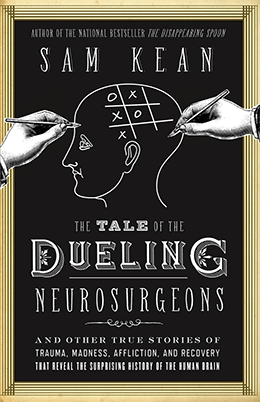By Germaine Cornelissen-Guillaume
The dueling neurosurgeons in Sam Kean’s book are Ambroise Paré and Andreas Vesalius, who were summoned by Queen Catherine de Medici to look after King Henri II after the lance of the captain of his Scottish Guard, Gabriel de Montgomery, struck the king below the neck in a jousting accident. Ambroise Paré was one of the king’s royal surgeons. Having practiced medicine on the battlefield, he became a pioneer in surgical techniques, notably in the treatment of wounds. Andreas Vesalius was serving in the court of Philip II of Spain, whose marriage to Henri’s daughter, Elisabeth of Valois, was being celebrated on that fatal day. Vesalius revolutionized anatomy by exposing Galen’s shortcomings as he relied on human dissection. Drawing on different expertise in judging Henri II’s condition, Ambroise Paré and Andreas Vesalius focused on the brain alone, deviating from medical practice at the time. They determined that the king’s brain was injured even though his skull suffered no fracture, a milestone finding in the annals of neuroscience.
During the ten days until Henri’s death, the two neurosurgeons witnessed many of the important discoveries in neuroscience that were to be made over the next four centuries, many of them serendipitously. These findings are the essence of Kean’s book. They are told in a series of stories of people who suffered from various medical conditions such as blindness, epilepsy, syphilis, strokes, brain tumors, meningitis; were the victims of war; or experienced some horrific accident. Their surprising survival and the transformations that accompanied their misfortune serve as the background for Kean to skillfully chronicle some of the greatest advances in neuroscience since the 16th century. The author’s engaging narratives vividly portray the lives of neurosurgeons who elucidated some of the brain’s mysteries, told in the context of history as well as in the perspective of current knowledge.
For instance, the reader will learn about the contribution of Golgi and Cajal to our understanding of cell communication, and about Loewi’s landmark experiment which demonstrated that signaling across the synapse involved chemicals. The ability of the brain to rewire itself is illustrated by uplifting stories of a blind Navy lieutenant who travelled the world using his cane for echolocation, and of a blind sixteen-year-old boy who learned to see by using a device that swaps tiny cameras for eyes and transforms the images into electrical impulses that are felt on the tongue. Sam Kean stresses the synergy between war and medicine. As an example, the fact that our mind uses specialized circuits for certain tasks became evident from the mapping of the visual cortex by Inouye when bullets in the Russo-Japanese war of 1904 penetrated the skull, making clean, precise wounds, and from the work of Hubel and Wiesel. Phantom limbs and studies of people afflicted by kuru in Papua New Guinea (that ultimately led to the discovery of prions) illustrate how the brain controls the body and directs its movement. Cushing’s work on the pituitary was particularly important to understand how the brain influences the body and even our emotions, as also evidenced by cases of lesions in the thalamus—hence the horror of lobotomies that severed links between the frontal lobe and limbic system, thereby destroying emotional experiences. Next, Kean recounts how electrical stimulation was instrumental in mapping the cortex with greater precision, allowing the study of how the brain works in real time. Recording the electrical activity of the brain of his students, Libet demonstrated that the unconscious electrical processes in the brain precede conscious decisions to perform volitional, spontaneous acts, thus challenging the concept of free will. The last three chapters delve into distinct types of memory, time estimation, speech and language, and the sense of self, drawing on the amazing story of Phineas Gage whose personality changed completely after his skull and brain were accidentally pierced.
Kean’s choice of stories, some tragic, some uplifting, and some even enchanting, illustrates the brain’s resiliency and its ability to rewire itself. With each new chapter, Kean threads deeper into the brain, first exploring small physical structures like neuronal and glial cells and how they communicate, then investigating how the brain and body work together, to finally touching on memory, emotions, free will and consciousness, bridging physiology and psychology, physical and mental functions, body and mind. Each case relates to the working of different parts of the brain, so that by the last chapter, the reader has gained a glimpse at how they work together.
As Henri II drifted in and out of consciousness during the last few days of his life, the seizures and temporary paralysis that deranged only half of his body at any one time foreshadowed lateralization of brain function. His occasional vision loss was an indication that the sense of sight resides at the back of the brain, where Paré expected the king’s brain to be damaged. The worsening headaches were a sign of inflammation, the secondary effect of trauma that can prove more deadly than the initial blow. The kind of brain damage Vesalius and Paré had predicted to find was revealed correct at autopsy, surprisingly permitted by Catherine at a time when it was considered disreputable.
Kean’s writing is engaging and entertaining. In easily understood prose, he covers important breakthroughs in neuroscience based on some of the most notorious neurological curiosities that helped discover how the brain works before the advent of fMRI and other brain-scanning technologies.
Germaine Cornelissen-Guillaume is a professor of integrative biology and physiology and director of the Halberg Chronobiology Center at the University of Minnesota, Twin Cities.




